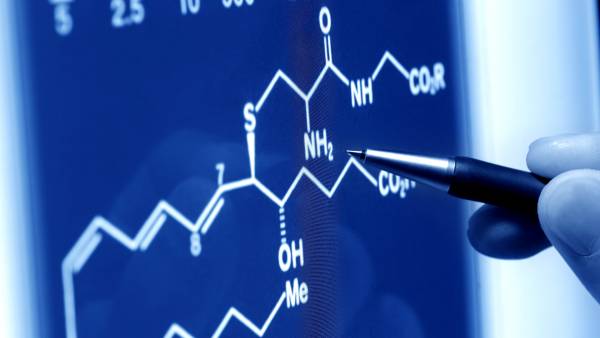I have been working in the supplement industry for over ten years now, and there has never been such a push to consume amino acids as there is right now. These aminos have been flying off the shelves in supplement stores across the country, and after returning home from the Mr. Olympia show in Las Vegas, I had more amino samples than I knew what to do with.
Put aside the marketing genius of these massive supplement companies and ask yourself two major questions: What are they and why should I be taking them?
What Are Amino Acids?
In order to attempt to scratch the surface of these questions, I need to start with slightly bigger concepts, and then narrow it down to more specific uses of amino acids. First, proteins catalyze the vast majority of chemical reactions that occur in our cells. They also provide structure to cells, bind them to tissue, and even make cell movement possible. Others are responsible for the transport of vital materials from the outside of the cell (extracellular) to its inside (intracellular). Even though there are so many different uses for proteins, when hydrolysis occurs, more simple compounds are revealed. These are the building blocks of proteins, called amino acids.
Amino acids are organic compounds which contain at least one amino group (-NH2) and a carboxyl (-COOH) group. In the human genome, 20 amino acids are utilized to build proteins, and therefore are termed proteinogenic. Besides this, there are approximately 250 amino acids which do not form proteins but may be used to form sugar, for example.1 These amino acids can be divided even further into three groups: essential, conditionally essential, and nonessential.
Before we dive into the purpose of each individual amino, we need to understand the major differences between these three groups. These groups can easily be related to the process of baking cookies:
- Your flour, eggs, oil, and butter represent the nonessential and conditionally essential groups because you have these items in your cupboard all the time and don’t need to worry about purchasing them every day.
- Your essential amino acids are the chocolate chips or the walnuts in your recipe, since they are more specialty items that aren’t typically stored at your home.
Nonessential and conditionally essential amino acids are made in your body, so you don’t necessarily need to eat them. You need essential amino acids in your daily diet because your body cannot make them. If you do not get essential amino acids in your diet, proteins break down, resulting in muscle loss and problems with repair. Knowing which foods provide all or some of the essential amino acids helps you make sure your body gets adequate amounts.
Where to Get Your Essential Aminos
Food protein containing all nine essential amino acids in adequate amounts is called a complete protein. When proteins are digested, the resulting amino acids are absorbed in the small intestine. However, in order for amino acids to be properly absorbed, sufficient vitamins B12 and C, chromium, and sleep are required. Whether you are a meat eater, vegan, or vegetarian, there are plenty of options to choose from to help satisfy your daily protein requirements. Take a look at the list below and see if you can find if one or more of these items will work for you.
- Complete Animal Proteins: Liver (chicken, pork, beef), goose, duck, turkey, chicken, lamb, pork, most fish, rabbit, eggs, milk, and cheese (cottage, gjetost, cream, Swiss, ricotta, limburger, gruyere, gouda, fontina, edam)
- Complete Plant Proteins: Spinach, some beans (black, cranberry, French, pink, white, winged, yellow), soy, split peas, chickpeas, chestnuts, pistachios, pumpkin seeds, avocado, potatoes, and quinoa
- Incomplete Plant Proteins: Rice (white and brown), white bread (including whole-wheat), pasta, some beans (adzuki, baked, kidney, lima, pinto, snap), peas, lentils, nuts (walnuts, peanuts, hazelnuts, almonds, coconut), sunflower seeds, and kamut
These whole foods are the first things I direct my athletes to before I even begin talking about supplementation. I am a firm believer in eating food to fuel your body before you begin to supplement your diet with added proteins, aminos, and carbohydrates. However, most of us run at 88 mph all day long and fail to meet our daily nutritional requirements with just food, which makes nutritional supplements vital for our health.

Before you look to science to solve your problems, make sure your diet is in order.
The Roles of Individual Aminos
Now that we have a basic understanding of proteins and how we can support our daily requirements through food, let’s continue to funnel down to the differences within each of the three amino categories:
Essential Amino Acids
- Histidine: Found abundantly in hemoglobin; has been used in the treatment of rheumatoid arthritis, allergic diseases, ulcers, and anemia.
- Isoleucine: Stimulates the brain to produce alertness.
- Leucine: Stimulates protein synthesis and storage, as well as promotes the healing of bones, skin, and muscles. It must be used in combination with I-valine and I-isoleucine.
- Lysine: Found in the muscle tissue; ensures the adequate absorption of calcium; helps form collagen; aids in the production of antibodies, hormones, and enzymes.
- Methionine: Natural chelating agent for heavy metals; a principle supplier of sulfur which prevents disorders of the hair, skin, and nails; promotes hair growth.
- Phenylalanine: Understood to perform as a pain reliever; used by the brain to produce norepinephrine, a chemical that transmits signals between nerve cells and the brain; helps maintain alertness; reduces hunger; acts as an antidepressant and helps improve memory.
- Threonine: Least abundant amino acid; essential in preventing fat buildup in the liver and assisting digestive and intestinal tracts to function more smoothly; assists metabolism and assimilation.
- Tryptophan: Natural relaxant; helps alleviate insomnia by inducing normal sleep; reduces anxiety and depression; and helps in the treatment of migraine headaches.
- Valine: Promotes mental vigor, muscle coordination, and calms emotions.
Now that we know what these essential amino acids do, how much do we need to take in order for them to be effective? Because the essential amino acids are the only ones that we need to actively consume, they are the only ones with daily consumption recommendations. Dr. David McAuley gives the following recommended daily intake for adults who are 19 years of age or older:
- 14 mg/kg/day of histidine
- 19 mg/kg/day of isoleucine
- 42 mg/kg/day of leucine
- 38 mg/kg/day of lysine
- 19 mg/kg/day of methionine + cysteine
- 33 mg/kg/day of phenylalanine + tyrosine
- 20 mg/kg/day of threonine
- 5 mg/kg/day of tryptophan
- 24 mg/kg/day of valine
Conditionally Essential Amino Acids
- Arginine: Improves immune responses to bacteria, viruses and tumor cells; promotes wound healing and regeneration of the liver; causes the release of growth hormones; considered crucial for optimal muscle growth and tissue repair; helps arthritis sufferers by stimulating the growth of new bone and tendon cells.
- Cysteine: Protects cells from the harmful effects of radiation; protects the liver and brain from damage due to alcohol and cigarette smoke.
- Glutamine: Works with glucose to provide the fuel the brain cells need to think clearly and help combat fatigue.
- Glycine: Helps trigger the release of oxygen for the cell-making process; important in the manufacturing of hormones responsible for a strong immune system.
- Proline: Essential for proper functioning of joints and tendons; helps maintain and strengthen heart muscles.
- Serine: Assists the storage of glucose in the liver and muscles; helps strengthen the immune system by providing antibodies; synthesizes fatty acid sheath around nerve fibers.
- Tyrosine: Transmits nerve impulses to the brain; helps overcome depression; improves memory; increases mental alertness; promotes the healthy functioning of the thyroid, adrenal, and pituitary glands.
Nonessential Amino Acids
- Alanine: Important source of energy for muscle tissue, the brain, and central nervous system; strengthens the immune system by producing antibodies; helps in the metabolism of sugars.
- Asparagine: Along with glutamine and serine, it is vital at the intracellular level for energy and smooth function of brain reactions; contributes to the formation of proteins, muscles, neurotransmitters, antibodies, and receptors; important transporter of nitrogen; foundation of carbohydrate metabolism; improves recovery after surgery or trauma by hastening wound healing.
- Aspartic Acid: Aids in the expulsion of harmful ammonia from the body. Recent studies have shown that aspartic acid may increase resistance to fatigue and increase endurance.
- Glutamic Acid: Improves mental capacities; helps speed the healing of ulcers; supports your digestive tract; helps control the craving for sugar.
Are You Getting Enough Aminos?
Due to the many uses and importance of these amino acids in our bodies, it’s imperative that we get enough. Deficiency is far more often the problem than excess aminos. In developing countries, protein deficiency is a huge medical issue with protein-energy malnutrition affecting 500 million people every year and killing 10 million of them. While it’s rare in developed countries, protein deficiency does affect the poor, and often occurs in those who are crash dieting to lose weight or in older adults, leading to conditions like osteoporosis. Those recovering from surgery, trauma, or illness can also be protein deficient if they don’t increase their dietary intake to match their increased needs. Our bodies use protein when we’re healing, so it’s important to eat lots of it when we’re sick or recovering.2
Protein deficiency is a far more common problem than we think, and many people suffer from less obvious effects. There are studies that have shown lower protein intake in certain minorities. Some biologists have argued that a very slight protein deficiency might actually explain some of the variance in academic performance between poor minority and richer majority students.3 Since so much of brain function is tied to proper nutrition and protein intake, it’s entirely possible that even small changes in protein consumption, like that of crash dieters, could have an impact on mood and cognition. A deficit in dietary protein for infants can have a marked effect on their intelligence as older children, especially for boys.4
The need for amino acids, or protein as a whole, cannot be overstated. With an increase in bodyweight, activity level, or with illness, your protein requirements increase. The standard equation for daily protein requirements is 1 to 1.5 grams of protein per kilogram of bodyweight, so keep that in mind when supplementing with proteins and aminos. The aminos that you do choose to supplement with need to be consumed between meals if you are choosing foods that are complete proteins. Most aminos have muscle-sparing, energizing, and motivational properties that are useful between meals. Even though a healthy diet rules out the need for any and all separate amino acids, they remain a useful, and healthy part of our industry.
Once you’ve nailed your protein intake, you’re only partway there:
Protein Is Only One Piece of the Nutritional Puzzle
References:
1. Reddy, M. K. (2015, December 18). Amino acid. Retrieved September 27, 2016.
2. Collins, N., & Shnitzer, A. (n.d.). How dietary protein intake promotes wound healing. Retrieved September 27, 2016.
3. Lovejoy JC, Champagne CM, Smith SR, de Jonge L, & Xie H (2001). Ethnic differences in dietary intakes, physical activity, and energy expenditure in middle-aged, premenopausal women: the Healthy Transitions Study. The American Journal of Clinical Nutrition, 74 (1), 90-5 PMID: 11451722.
4. Lucas, Alan, Ruth Morley, and Tim J. Cole. “Randomised trial of early diet in preterm babies and later intelligence quotient.” British Medical Journal 317, no. 7171 (1998): 1481-1487.






